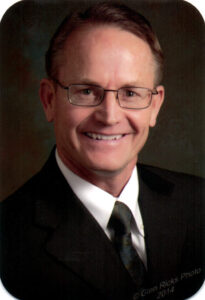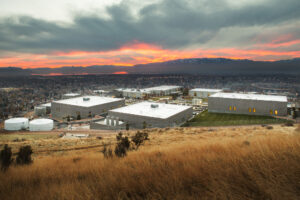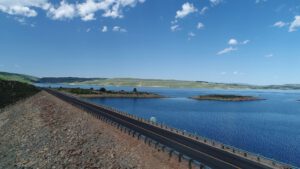In an interview with Municipal Water Leader’s editor-inchief, Kris Polly, Gene Shawcroft, general manager for CUWCD, discusses the CUWCD area’s growth, the challenges CUWCD is facing, and how the six water conservancy districts are preparing for 2060.
 Kris Polly: How many years have you been with CUWCD?
Kris Polly: How many years have you been with CUWCD?
Gene Shawcroft: I started with CUWCD in 1991. I was with the state of Utah’s Division of Water Resources for 6 years prior to that. I grew up on a cattle farm in LaJara, Colorado, so I have played in water my entire life and have loved every minute. Given the elevation of my family farm, the growing season was quite short, so we got two crops of alfalfa hay and raised a little wheat, barley, and oats. We flood irrigated and generally got only two irrigations per year. On average, we get about 7 inches of precipitation a year, and two-thirds of that would be snow during the winter.
Kris Polly: What are the biggest challenges facing CUWCD?
Gene Shawcroft: Addressing the anticipated growth in the region. Within our district boundaries, we will double in population within the next 45 years. For Utah County, that is over 1.5 million people—and we are only about 600,000 today.
The other issue we are really focused on is aging infrastructure. The Bureau of Reclamation provided 100 percent of the initial funding for the construction of the project through 1992. From then onward, it has been 65 percent. We have been reimbursing Reclamation for its contributions. We don’t see the federal government having another $3 billion to throw at us in the next 50 years to replace it all.
We anticipate that one of the challenges will be developing a strategy that will allow us to provide a culinary water supply without interruption to well over 1 million people and eventually to 2.5 million people in our service area over the next 40 years.
Kris Polly: Please tell us a little bit about the Prepare 60 program.
Gene Shawcroft: Prepare 60 was the brainchild of the four large water conservancy districts in Utah. They are Weber Basin Water Conservancy District, Jordan Valley Water Conservancy District, Washington County Water Conservancy District, and CUWCD. CUWCD serves about 62 percent of the state’s population, and the four Prepare 60 districts account for about 85 percent of the state’s population.
It seemed obvious to us that there was a void in the state of Utah in terms of a general water message, and it has probably been 5 years ago that we met with Governor Gary Herbert. During the meeting, Governor Herbert requested a roadmap of how we are going to be able to supply water to the municipal and industrial interests across the state over the next 50 years so that future growth is not restricted. As a result, we created Prepare 60—its full name is Prepare 2060. We have tried to have a consistent message across the state about conservation, which is critical, but conservation is not the only way we are going to meet our future water demands in Utah. We also want to have a combined effort with our legislative team and the governor’s office on the need for additional water financing.
 In the mid-1980s, there was a dedicated sales tax divided between water and transportation. Over time, more money was allocated to transportation, but the amount allocated to water remained constant. We put our heads together and devised another revenue stream just for water, which will put us in a much better position than we are today. By working together, the legislature passed a dedicated sales tax for water. The full amount of the revenue will be phased in over a 5-year period, with a 20 percent increase each year. Once it is fully implemented, we will have an ongoing revenue stream, which can be used to assist in acquiring bonds to help finance large water development projects.
In the mid-1980s, there was a dedicated sales tax divided between water and transportation. Over time, more money was allocated to transportation, but the amount allocated to water remained constant. We put our heads together and devised another revenue stream just for water, which will put us in a much better position than we are today. By working together, the legislature passed a dedicated sales tax for water. The full amount of the revenue will be phased in over a 5-year period, with a 20 percent increase each year. Once it is fully implemented, we will have an ongoing revenue stream, which can be used to assist in acquiring bonds to help finance large water development projects.
When the four water conservancy districts began collaborating, there were two main areas of focus of our Statewide Water Infrastructure. The first focus area was rehabilitating and or replacing aging infrastructure. We have large facilities that will have to be replaced over the next 40 to 50 years, so we are naturally looking at ways to provide funding locally to address those future costs. We set out to determine what it would take for us to deliver the same amount of water that we are currently delivering today for the future citizens and businesses of Utah in the year 2060. This cost was approximately $18 billion. The second focus area was to explore what it would cost to develop new water supplies for the new people we anticipate being here by 2060. That number was slightly less—$15 billion. We used this analysis when approaching the legislature and water community at large to discuss our water financing needs. As a result, the state legislature acted to provide an additional revenue stream for water, which will help to finance these long-term needs.
CUWCD meets every 5 to 6 weeks with the other conservancy districts to compile information for municipalities and newly elected officials so that they have information on water. This helps us expand our message across the state.
Kris Polly: Would you tell us a bit more about the meetings of the four partners?
Gene Shawcroft: Before each meeting, we each add items to a shared agenda. Everyone can see what we are going to accomplish before the meeting begins. Early on, our agendas included messaging meetings scheduled, what our focus was with that particular group, and which conservancy district was in the best position to present the message. Reflecting on our meetings, they were initially more of an organization event. More recently, we are talking more about strategy. We frequently look at pending or needed legislation, project financing, and long-term efforts for larger infrastructure projects.

Logistically, we get the four water conservancy districts together with a consultant who helps coordinate our meetings, messages, and concepts so that we have more of an awareness than just the water districts’ perceptions. For the most part, we are focused on managing our districts, so the outside perspective helps our relationships with the broader business and development communities.
We have a fairly vocal group in Utah that is concerned with growth. There are efforts to use our limited water resources as a reason to restrict growth. As a result, efforts are underway to restrict funding for water, which will decrease the development of water and thus limit growth. Our strategy as managers is to provide water based on the growth decisions made by the broad community and not narrow the growth discussion simply to the availability of water.
Recently, we’ve been focusing on strengthening our relationship with the Utah League of Cities and Towns. There are 400-plus towns and communities in the state, many of which are our customers. Our efforts have been to coordinate lobbying and ensure that our messages are consistent.
Kris Polly: What are some of the critical infrastructure projects that CUWCD needs to address in the near term?
Gene Shawcroft: We are in the design process for the North Fork Siphon. This mile-long siphon drops 700 feet across a canyon. It was built with prestressed concrete cylinder pipe, which has been catastrophically failing across the country. When the wire wraps in the concrete begin to corrode, the thin, steel interior can rupture. It almost explodes. We have been monitoring our siphon closely and determined that it doesn’t have a long life left. Rather than wait, we are in the process of replacement.
We aim to start construction this fall. This project is located at an elevation of 8,000 feet. We will build a parallel pipe to it, and then during the offseason, we can make the connection. We’ll leave the old pipe in place; the canyon walls are very steep, and there would be environmental damage if we tried to repair or replace it. That is a $25–30 million job.
Kris Polly: How do prepare your customer base for the cost of these upcoming large-scale, capital-intensive projects?
Gene Shawcroft: A number of years ago when the Water Conservancy District Act was passed in Utah, it gave each of our four districts property tax authority, and that property tax was leveraged to pay back the federal government for the reimbursable costs of projects like the Central Utah Project. We are fortunate in that we are a public entity with taxing authority. We currently employ that authority to repay the federal government for the debt we have incurred up to this point.
As we get that paid off, our strategy is twofold: (1) we will continue to assess that property tax, which is 4 mils, and begin to apply it to rehabilitation projects and (2) through our long-term asset management program, we have determined our ultimate need to maintain our operations per acre-foot of water and developed an appropriate rate structure.
 We have an operation and maintenance reserve and a replacement reserve. We have started to assess $5 per acre-foot; that rate increases $10 a year for 5 years. At the end of the 5-year period, we will evaluate the increases with the board of trustees—where we are, what projects we have built, and what we need to replace. We ultimately will need somewhere around $300 per acre-foot. Half of that would come from property tax and half would come from rates. You can see that we have a challenge ahead.
We have an operation and maintenance reserve and a replacement reserve. We have started to assess $5 per acre-foot; that rate increases $10 a year for 5 years. At the end of the 5-year period, we will evaluate the increases with the board of trustees—where we are, what projects we have built, and what we need to replace. We ultimately will need somewhere around $300 per acre-foot. Half of that would come from property tax and half would come from rates. You can see that we have a challenge ahead.
When you deal with projects with a 50- to 75-year life, the important thing is to start somewhere, as opposed to waiting until you need $50 million or more in a single year. With a consistent rate structure, you can bond against that revenue stream if needed. What we can’t do is go to the bond market and bond against a revenue stream that does not exist.
That is key as we look to the future, because as we pay off the debt for the facilities, it will be time to rebuild them due to their age. We would be elated if federal dollars became available, but realistically, we see this burden as being on our shoulders, so we are working to secure local funds for projects for future generations. With stable property tax revenue, we have higher bond ratings, which allows us to go to the bond market and borrow at the lowest rate to keep the cost of debt as low as possible.
Kris Polly: What is your advice to other water agencies in other parts of the country?
Gene Shawcroft: First of all, we live in a global community. With our thought process, as we look to the future we are not just looking at one particular area. Instead, we are trying to form a cooperative game plan for our region that allows us to conjunctively use our import water, our surface water, our groundwater, and our treatment plants, so that we can afford it and to ensure it delivers water into the future. We have learned that for the most part, municipalities are designed to plan 10 years into the future and to plan locally. When you look at water, 10 years is too short of a planning horizon. Long-term plans that cover large areas provide efficiencies that are not possible in short-term or local plans.
Kris Polly: Based on your many years of experience working in municipal water, what is the most important and helpful thing you have learned?
Gene Shawcroft: The simple answer is relationships. It may sound overly simple, but the trust that is necessary in the complex water world is key to being successful. Establishing relationships along the way in a career is not only valuable from a business perspective; getting to know people and developing friendships is what really makes the water world enjoyable.
Kris Polly: What is your advice to anyone who is beginning their career in municipal water?
Gene Shawcroft: I’d have three suggestions. The first relates to the above statement regarding relationships. Look for ways to get to know people and make friends. The second is to understand that the knowledge and skills you bring to the table as you begin your career will expand quickly. You should work to learn as much as you can. The technology and information currently available is phenomenal. Never stop striving to learn as much as you can, and generally, the best information available is from your coworkers and peers in the industry. Third, as your career progresses, stop to appreciate the great value and service you provide to the community you serve. I can’t think of a more critical resource to the quality of life than water. You will play a key role in making sure the people you serve have this most precious resource.
Gene Shawcoft is the general manager of Central Utah Water Conservancy District. He can be reached at gene@cucwd.com.
